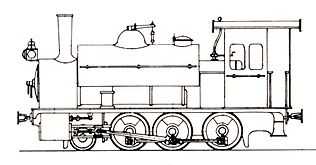CGR 2-6-0ST 1900
| CGR 2-6-0ST 1900 ex Harbour Board PE 2-6-0ST 1900 to South African 2-6-0ST 1900 | |
|---|---|
|
Drawing of CGR 2-6-0ST locomotive of 1900 | |
| Type and origin | |
| Power type | Steam |
| Designer | Kitson and Company |
| Builder | Kitson and Company |
| Build date | 1900-1903 |
| Specifications | |
| Configuration | 2-6-0ST "Mogul" |
| Gauge | 3 ft 6 in (1,067 mm) Cape gauge |
| Leading wheel diameter | 24 in (610 mm) |
| Driver diameter | 39 in (991 mm) |
| Wheelbase |
7 ft 6 in (2.286 m) drivers 11 ft 4 in (3.454 m) engine |
| Length | 23 ft 4 in (7.112 m) over couplers |
| Height | 11 ft 4 in (3.454 m) |
| Axle load | 7 8⁄20 long tons (7.5 t) on middle driver |
| Weight on drivers | 20 8⁄20 long tons (20.7 t) |
| Locomotive weight | 25 15⁄20 long tons (26.2 t) w/o |
| Fuel type | Coal |
| Fuel capacity | 1⁄2 long ton (0.5 t) |
| Water capacity | 600 imp gal (2,700 l; 720 US gal) |
| Boiler |
9 ft 3 3⁄16 in (2.824 m) inside length 5 ft 8 in (1.727 m) pitch |
| Boiler pressure | 160 psi (1,100 kPa) |
| Firegrate area | 10 sq ft (0.929 m2) |
| Heating surface: – Tubes |
116 tubes 1 3⁄4 in (44.4 mm) diameter 494 sq ft (45.894 m2) |
| – Firebox | 50 sq ft (4.6 m2) |
| – Total | 544 sq ft (50.5 m2) |
| Cylinders | Two |
| Cylinder size |
13 in (330 mm) bore 20 in (508 mm) stroke |
| Valve gear | Stephenson |
| Performance figures | |
| Tractive effort | 10,400 lbf (46 kN) at 75% pressure |
| Career | |
| Operator(s) |
Port Elizabeth Harbour Board Cape Government Railways South African Railways |
| Number in class | 3 [1][2] |
| Number(s) |
PEHB I, J & O CGR 1024-1026 SAR 01024-01026 [3] |
| Delivered | 1900-1903 |
| First run | 1900 [1][2] |
The CGR 2-6-0ST of 1900 is a South African steam locomotive from the pre-Union era in the Cape Colony.
In 1900 two 2-6-0 Mogul saddle-tank locomotives entered shunting service at the Port Elizabeth Harbour, followed by one more in 1903. They were later taken onto the Cape Government Railways roster and were all still in service when the South African Railways was established in 1912.[1][2]
Manufacturer
Two 2-6-0 saddle-tank locomotives were delivered to the Port Elizabeth Harbour Board (PEHB) from Kitson and Company in 1900, followed by one more from the same manufacturer in 1903. They were similar in appearance and general dimensions to the 1st Class 2-6-0ST of 1876, that had been rebuilt from tender to saddle-tank locomotives by the Cape Government Railways (CGR) in the 1880s for use as shunting engines, but were slightly larger and with an increased heating surface and tractive effort.[1]
Service
The PEHB used letters to number its locomotives at the time and the first two of these engines were lettered I and J, while the one that was delivered in 1903 was lettered O. In 1908 they were taken onto the CGR roster and numbered in the range from 1024 to 1026.[3]
The Union of South Africa was established on 31 May 1910, in terms of the South Africa Act. One of the clauses in the Act required that the three Colonial Government railways, the CGR, the Natal Government Railways and the Central South African Railways, also be united under one single administration to control and administer the railways, ports and harbours of the Union. While the South African Railways (SAR) came into existence in 1910, the actual classification and renumbering of all the rolling stock of the three constituent railways required careful planning and was only implemented with effect from 1 January 1912.[4][5]
These locomotives spent their entire service lives as dock shunters in the Port Elizabeth Harbour. In 1912 they were considered obsolete by the SAR and renumbered by having the numeral 0 prefixed to their existing numbers. Even though obsolete, they remained in service until 1931.[1][2][5]
See also
- CGR 1st Class 2-6-0ST 1876
- CGR 2-6-0ST 1902
- List of South African locomotive classes
- South African locomotive history
- The 2-6-0 "Mogul"
References
- ↑ 1.0 1.1 1.2 1.3 1.4 Holland, D.F. (1972). Steam Locomotives of the South African Railways, Volume 2: 1910-1955 (1st ed.). Newton Abbott, Devon: David & Charles. p. 120. ISBN 978-0-7153-5427-8.
- ↑ 2.0 2.1 2.2 2.3 Paxton, Leith; Bourne, David (1985). Locomotives of the South African Railways (1st ed.). Cape Town: Struik. p. 16. ISBN 0869772112.
- ↑ 3.0 3.1 Updated information on the 1st Class Kitsons
- ↑ The South African Railways - Historical Survey. Editor George Hart, Publisher Bill Hart, Sponsored by Dorbyl Ltd., Published c. 1978, p. 25.
- ↑ 5.0 5.1 Classification of S.A.R. Engines with Renumbering Lists, issued by the Chief Mechanical Engineer’s Office, Pretoria, January 1912, pp. 13, 17. (Reprinted in April 1987 by SATS Museum, R.3125-6/9/11-1000)
